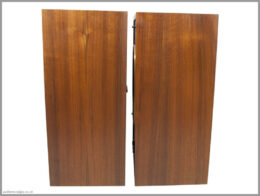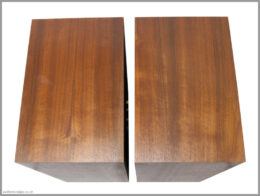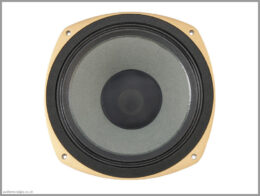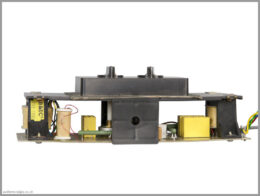TABLE OF CONTENTS
MY STORY
Since purchasing Tannoy Little Gold Monitors, I always wondered if there is much difference between them and Tannoy Little Red Monitor speakers. In my opinion both look equally good, but the LGMs replaced LRMs, so the logic would suggest that Tannoy LGM should outperform Tannoy LRM. I was lucky enough to pick up a pair of Little Reds from a gentleman not too far away from where I live. They belonged to his late father and were in a pretty nice condition. I still had the Tannoy LGM at the time, so I was able to run side by side comparisons.
Please note – usually before reviewing vintage speakers, I recap the crossovers to ensure that capacitors are within manufacturer’s specification. On this occasion, caps were within the specs, so there was no need to replace them. Also, bear in mind that purchasing vintage speakers is always a gamble. 30 and often 50 years it’s a long time, and one can never be sure how this time affected the loudspeaker drivers. Consequently, it is possible that the Tannoy Little Red Monitor speakers that you have purchased will measure and sound different than the pair I reviewed.
SPEAKER INFO
Model History
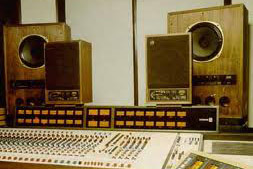 Tannoy Little Red Monitor speakers were developed with nearfield studio monitoring in mind, and recording/broadcasting studios are where most of these speakers were used (see the image on the left, that was found somewhere on the Internet). Many studios still
Tannoy Little Red Monitor speakers were developed with nearfield studio monitoring in mind, and recording/broadcasting studios are where most of these speakers were used (see the image on the left, that was found somewhere on the Internet). Many studios still  use them these days. I came across a photo of The Magic Numbers band, where one of the group members is casually sitting on the Tannoy LRM – see the image on the right. I was approached by a couple of UK based recording studios asking if I had any LGMs or LRMs for sale, so there is clearly still a demand for these among professional sound engineers.
use them these days. I came across a photo of The Magic Numbers band, where one of the group members is casually sitting on the Tannoy LRM – see the image on the right. I was approached by a couple of UK based recording studios asking if I had any LGMs or LRMs for sale, so there is clearly still a demand for these among professional sound engineers.
Design
Similarly to many other Tannoy designs, Tannoy LRM speakers feature famous ‘Dual Concentric’ construction which means that we have two diaphragms (HF and LF) combined in one driver and working on the same axis. For more information about this please see the Design paragraph in the Monitor Gold 15″ Review). Speakers from the ‘__ Red Monitor’ range are the predecessors of the ‘__ Gold Monitor’ range. To my knowledge the Red Monitor range was produced throughout the 80s, whereas the Gold Monitor range was a much shorter run, and was produced in the late 80s and early 90s. Please don’t confuse these with much older Monitor Red or Monitor Gold drivers from 60s and 70s.
TANNOY LITTLE RED MONITOR SPECS
| Frequency Response: | 55 – 20,000Hz (+/- 4dB) |
| Sensitivity: | 92dB (1W input, measured at 1m) |
| Impedance: | 6Ω (4Ω min.) |
| Recommended Amplifier: | 10 – 200W |
| High & Low Frequency Driver: | Type 3149R 300mm (12″) Dual Concentric with 51mm (2″) Aluminium Dome Compression Driver and 300mm (12″) Paper Diaphragm |
| Crossover Frequencies: | 1,400Hz |
| Enclosure Type: | Bass Reflex |
| Enclosure Dimensions (HxWxD): | 548x400x275mm (23x16x11″) |
| Weight: | 21kg (each speaker) |
| Production Year: | 1980s |
| Price When Launched: | Unknown |
| Equivalent Present Day Price: | Unknown |
| Current UK Price: | £600 to £1200 for a pair |
LOOK & FEEL OF TANNOY LITTLE RED MONITOR SPEAKERS
In my opinion, similarly to the Little Gold Monitors, Tannoy LRMs are among the best looking vintage speakers ever. The enclosures are made of 18mm chipboard and finished in oiled walnut veneer. The front baffle is slightly reassessed and finished in the same oiled walnut veneer, giving the speakers classic vintage look. They do not feature any internal bracings but there is a black rubber damping material (Dynamat-like) attached to the walls – most likely to help with deadening enclosure resonances or tuning them to a desired frequency.
The treble horn throats are bare alloy (i.e. unpainted) and gently glare through the centre of the coaxial drivers. Personally, I think that golden horn throats of the LGMs look a little more presentable. Nonetheless, drivers of the Little Reds are very neatly finished with the baskets made of golden anodised die cast alloy and featuring lot of ‘breathing’ space. The 12in bass diaphragms are made from rigid paper suspended on fabric surrounds which are not going to deteriorate with age. The 2in tweeter diaphragms are made of aluminium and are positioned behind the ferrite magnets.
The treble level controls are done via small rotary switches. These are known for oxidising and overtime causing issues with treble reproduction. This is probably the weakest part of this design. The crossovers feature fairly standard components. Interestingly, there is an additional board attached to the crossover via wiring loom (visible in the cabinet photo below) that is responsible for delaying high frequencies. As far as I am aware, this was done as a result of Little Red Monitors using flatter ferrite magnet as opposed to taller AlNiCo magnet used in older Tannoy drivers. Flatter magnet meant shorter horn throat, which then meant that the high frequency diaphragm was not aligned in phase with bass driver, creating a need for the time delay circuit. Internal wires and connectors are of decent quality but nothing over the top – computer 4 pin plugs and quite thick copper wires. Overall, Tannoy LRM are great ‘little’ speakers with very good finishing quality and plenty of attention to details.
SOUND OF TANNOY LITTLE RED MONITOR
First Impressions
There is something very alluring about the sound of vintage Tannoys and the LMRs do not disappoint in this area. Very similar character of sound and tonality to other Tannoy constructions from that period, yet with some subtle differences.
Bass
Let me start by saying that music lovers who like full bodied sound or deep bass will not be happy with the LRMs. Once you’ve heard songs with deep bass reproduced on a full range system, you cannot unhear it. These Tannoy Little Red Monitor speakers have -4dB at 55Hz and their frequency response rapidly drops below this level. Nonetheless, the bass they produce is very good indeed – fast, dynamic and with plenty of resolution.
Midrange and Treble
In contrast to bass, they definitely do not lack any midrange or treble. This is where Tannoy Little Red Monitor speakers surpass a lot of other constructions. They provide great level of details, decent transparency and very musical and engaging sound. Vocals and string instruments sound especially natural. Reproduction of guitar sound is among the best ones I have heard so far. This can be demonstrated on tracks such as Where Shall I Be by Eric Bibb, where you forget about everything else because Mr Bibb is playing in your living room.
In my experience, it is very hard to find speakers that are very transparent and not fatiguing to listen to. Tannoy LRM present a farily good balance between being transparent enough for you notice it, but not enough to sound very edgy. Some listeners may still find them fatiguing, especially especially because of limited low end extension.
Soundstage
Similarly to other Tannoy dual concentric designs, the illusion of soundstage depth is lacking. LRMs throw a wall of sound, and in my experience, never give you the feeling that musicians are playing from way behind the speakers. Despite this, they are still enjoyable to listen to and give an impression of the artists performing in your room, which can be appreciated on track such as Learn To Fly (Live) by Tom Petty.
Tannoy LRM VS Tannoy LGM
Before I had I chance to compare both constructions side by side, I thought that there will not be any noticeable difference in sound, as ultimately, most of the design and construction aspects are pretty much the same. When I started listening tests, I quickly discovered that the differences are much more noticeable than I anticipated. Saying that, tonally both speakers seem to be identical, but where the differences are is the transparency. The Little Red Monitors are not as transparent as Little Gold Monitors, but thanks to that, they are a lot more tolerable, which means that you can enjoy more of your music collection. This suits tracks like Waiting by Norah Jones which sounds much smoother on the LRMs. One of my favourite Rod Stewart’s songs, Maggy May (from the MTV Unplugged album), sounds too edgy on LGMs but is a lot more enjoyable on LRMs. On the other hand, some well recorded songs can sound astonishingly good on Little Golds, due to additional transparency and airiness.
In short, Tannoy Little Red Monitors are easier to listen to and enjoy, whereas Tannoy Little Gold Monitors are more revealing. It all comes down to personal preferences, but if had to choose between them and could only have one set of speakers, it would probably be the LRMs.
CONCLUSION
Tannoy Little Red Monitor speakers are quite transparent and very natural sounding but modest with bass. This makes them perfect for acoustic recordings but tracks relying on bass will make you feel that something is missing. They are easier on the ear than Tannoy Little Gold Monitors, so if high transparency is not your key priority and you still want a musical Tannoy sound, they may be just right for you. Overall, great sounding speakers but not good as all-rounders.
| Balance of Sound: | |
| Neutrality of Tone: | |
| Transparency: | |
| Soundstage: | |
| Attack: | |
| Engagement: | |
| Total Score: |
SONGS MENTIONED IN THIS REVIEW
Eric Bibb – Where Shall I Be
Norah Jones – Waiting
Rod Stewart – Maggy May (MTV Unplugged)
Tom Petty – Learn To Fly (Live)
Reviewed: July 2018 | Published: October 2018





